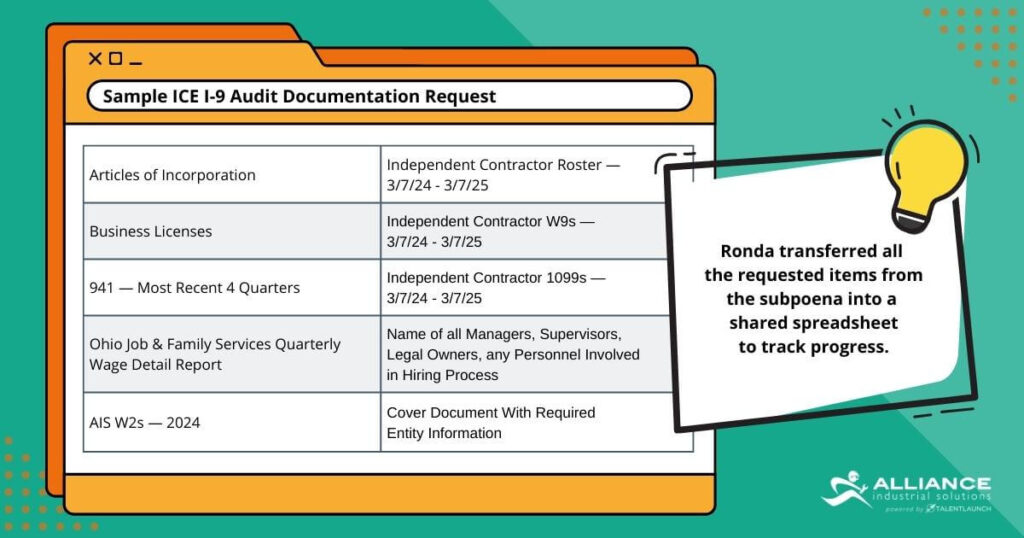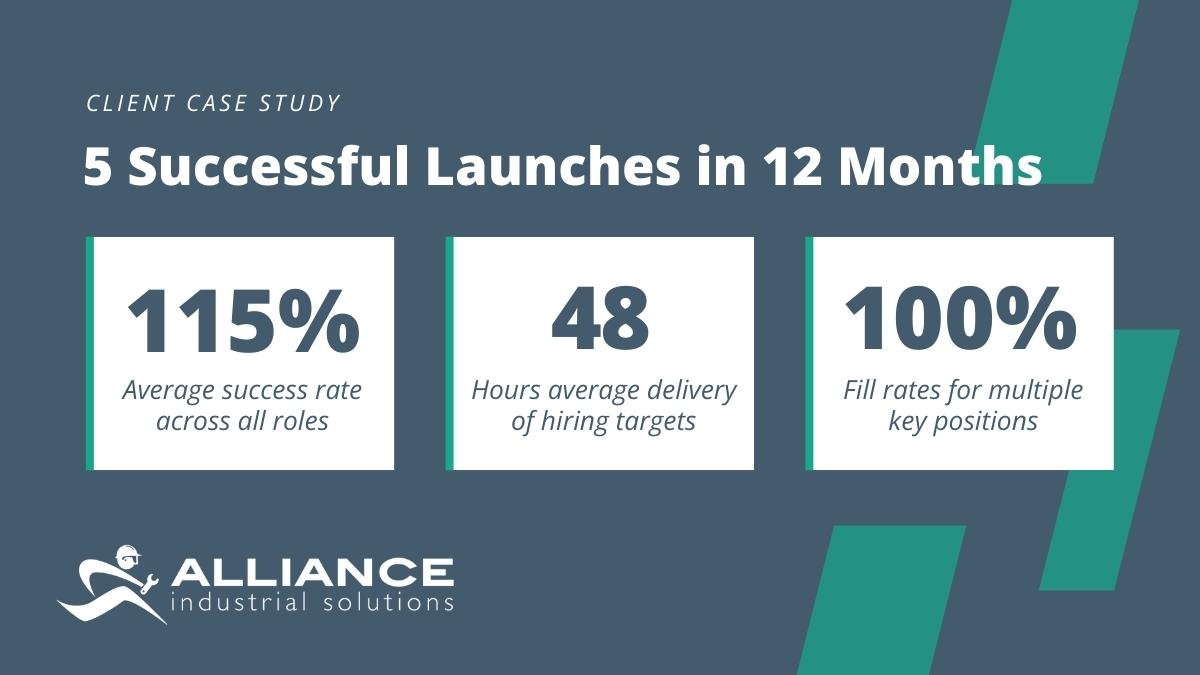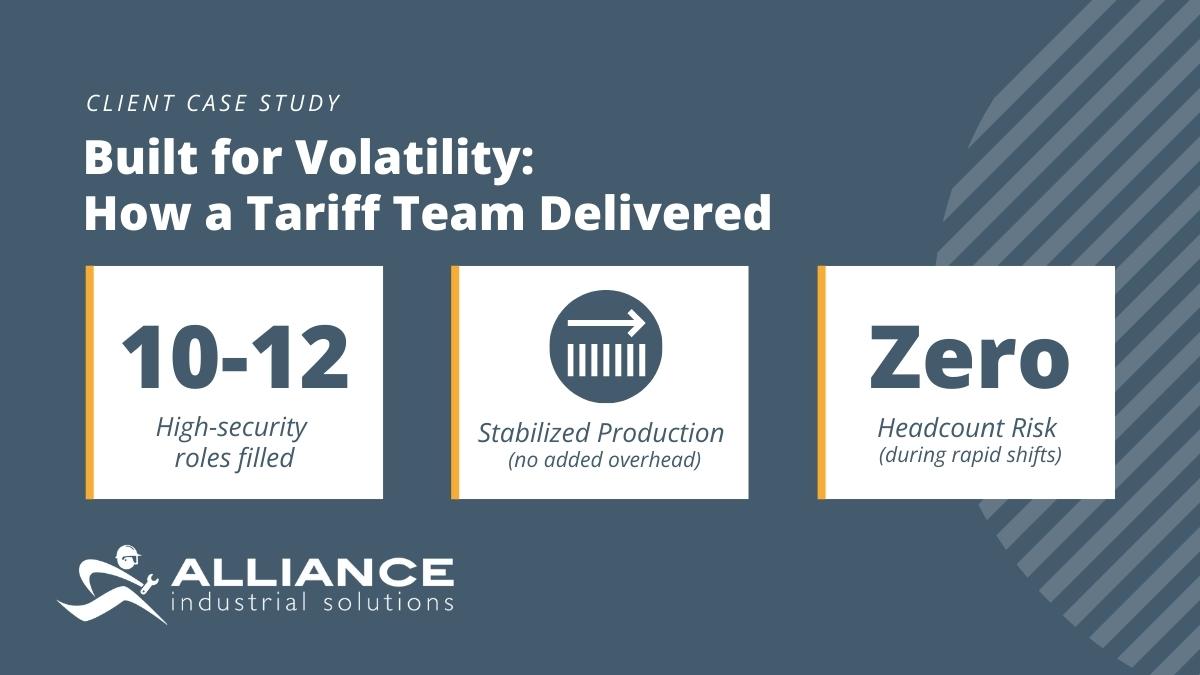Picture this: You’re having a normal work day, then—boom—two ICE agents walk in, body cams rolling, asking to speak to the manager (that’s you) somewhere a little more private. Cue the upper lip sweat.
They hand over an I-9 Notice of Inspection (NOI), briefly go over the pages, and give you exactly three business days to get your Form I-9s in order.
That’s exactly what happened to Dana Wegzynowski, Chief Operating Officer of Alliance Industrial Solutions.
His initial reaction? “I was confused, wondering why this was happening to us.” But a calm demeanor prevailed as he gathered the facts.
An unexpected visit from Immigration and Customs Enforcement (ICE) can send any HR or operations leaders into high alert.
With Dana’s insights—and those from Ronda Pineda, VP of HR at TalentLaunch—we’ve created an I-9 audit checklist to help your business to prepare. Think of it as your emergency manual, minus the tiny print and stress-induced caffeine overload.
Because nothing says “fun” like government compliance and paperwork, right?
What is the I-9 Compliance Audit?
An ICE I-9 compliance audit is not the same thing as an ICE raid. A raid involves a judicial warrant and can result in on-site arrests.
An audit, however, is a paperwork review—a subpoena that examines your company’s Form I-9 documentation to ensure all employees are legally authorized to work in the U.S.
These audits are becoming more common. While exact numbers are hard to find for 2021 and later, ICE conducted nearly 6,000 audits in fiscal year 2018 and 6,450 in Fiscal Year 2019 —a dramatic increase from just over 1,300 in 2017, according to the Society for Human Resource Management (SHRM).
What triggers an ICE audit?
That’s the million-dollar question. According to ICE, audits may be triggered by tips, public complaints, or suspicious activity, but they can also be purely random.
For Dana, there was no clear reason: “They didn’t state whether it was random or not, and I didn’t think to ask.”
And while ICE doesn’t release audit targeting criteria by industry, research shows that the hospitality, agriculture, construction, healthcare, and manufacturing industries are often subject to increased scrutiny.
Dana and Ronda both agree that all employers should expect an audit at some point. “The new administration is all over it.”
ICE I-9 Audit Checklist
Preparation is everything. Dana admits he felt unprepared but had confidence in the company’s processes. Ronda added that with many people involved in onboarding, it was difficult to know what to expect.
Here’s how they tackled the audit—and what they recommend you do in the same situation.
- Assemble a Response Team: Dana’s first call was to Ronda. She immediately gathered leaders from HR, Risk, Accounting, IT, and Legal for a strategy session. Everyone should know their role and be ready to act.
- Collect and Track Documentation: Ronda transferred all the requested items from the subpoena into a shared spreadsheet to track progress. This included hundreds of Form I-9s, plus records from E-Verify, Bullhorn (a network-wide talent database), and other internal applications.

- Establish Communication Channels: The team created a dedicated Google Chat for real-time updates and quick decisions. In an ICE audit, speed and coordination are everything.
- Hold Regular Meetings: Frequent meetings helped the team stay aligned and flag potential issues early.
“We did run into problems retrieving data from multiple systems and preparing identification records,” Ronda said, which made these regular meetings critical for troubleshooting.
- Move Fast—But Stay Organized: While ICE rarely grants extensions, Dana and Ronda were able to secure a 2-day extension.
“We were very grateful,” said Ronda. “Being a staffing agency, we had nearly 1,000 employee records to compile—it was an exhaustive process for such a small window of time.”
Dana’s advice? “Move fast because it’s a lot of work. Luckily, we have a big, fast, and smart team.”
Lessons Learned: After the (ICE) Storm
- Proactive Internal Self-Audits: Don’t wait for ICE to find the gaps. Ronda’s team conducts an annual random audit of 20% of hires, but both leaders agree it’s worth doing more often. Regular self-audits help catch errors before they become fines.
- Regular Training: Everyone who touches the I-9 process—HR, legal, accounting, onboarding—needs consistent training. Ronda’s team made I-9 training mandatory in 2023, including for all new hires.
- Strengthen Systems and Processes: Make sure your HR software can flag or block incomplete I-9s.
It’s also worth reviewing your onboarding processes to ensure I-9 completion and verification are treated as non-negotiable, early-stage tasks—ideally before the employee’s first day.
And if something feels off or inefficient in your process? Fix it now, not when the clock is ticking. Then test, train, and repeat.
Potential Consequences of Non-Compliance
While neither Dana or Ronda expect ICE to identify any compliance issues or gaps with their audit, it’s important to note that the penalties for non-compliance are no joke.
In fiscal year 2017, businesses faced:
- $97.6 million in judicial forfeitures, fines, and restitution
- $7.8 million in civil fines.
Even minor paperwork errors can add up fast, with civil fines ranging from $272 to $2,701 per I-9, depending on the violation, according to United States Citizenship and Immigration Services (USCIS).
“Non-compliance with employment verifications is not in anyone’s best interest,” Ronda said. “Even though E-Verify isn’t required federally, we use it as a standard safeguard.”
It’s also important to note that as of 2024, the number of employers enrolled in E-Verify (an online system for employment eligibility verification) has increased from roughly 920,000 in 2020 to over 1.3 million. This suggests a growing focus on employment eligibility verification in recent years.
Source
Final Thoughts: Surviving An ICE I-9 Audit
While an ICE audit might seem as enjoyable as a root canal, a little prep work goes a long way.
- Conduct regular I-9 audits
- Train your team annually
- Optimize and leverage your systems to prevent mistakes
- Stay cool—and caffeinated—if that NOI ever lands on your desk
Stay compliant. Stay prepared. And may your I-9s always be in perfect alphabetical order.
How We Can Help
Have questions about I-9 compliance? Need help building a process that keeps you audit-ready? Our staffing experts are here to help.
At Alliance Industrial Solutions, we support employers with workforce solutions that go beyond staffing. Whether you’re building a proactive compliance strategy or navigating an audit for the first time, you’re never in it alone.
Bookmark this article, forward it to your HR team, and maybe even print a copy for your emergency binder—because in the world of compliance, it’s not a matter of if, but when.





